Reviewer's Note: The RRT-2 Raptor was provided for review by JetBeam. Please see their website for more info.
UPDATE SEPT 27, 2011: JetBeam has released a new series of RRT lights, with a continuously-variable interface. Please seen my recent RRT-21 and RRT-15 review for more info.
UPDATE SEPT 22, 2010: As this review is over a year old, it is not surprising that the RRT-2 has gone through a number of build modifications. Please see post #98 by Ecodelosandes for some detailed pics of the currently shipping XP-G R5 edition of the RRT-2.
Warning: Pic heavy!
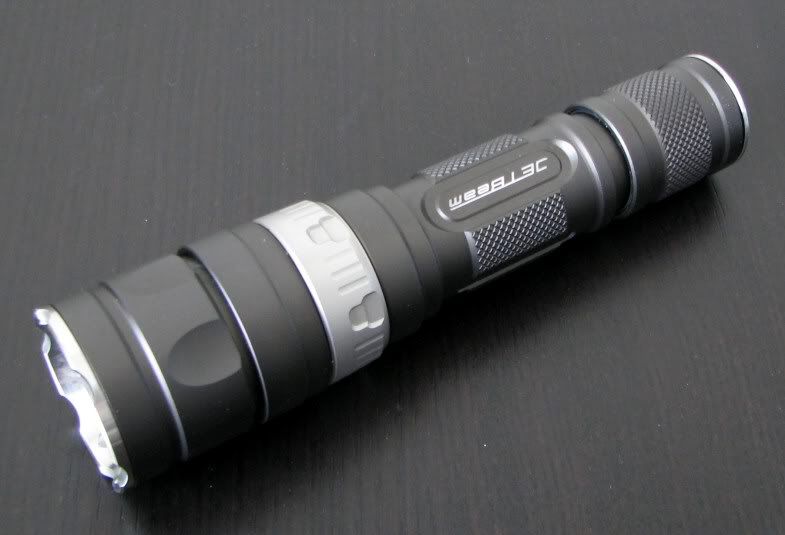
Manufacturer's specifications, as taken from JetBeam's website:
The RRT-2 is the "second generation" of the JetBeam Raptor line. The original RRT-1 Raptor was designed to be a fairly strong "thrower" with a simple control-ring user interface. The revised version has a much smaller head, but still provides significant throw for its size, thanks to a deep reflector.
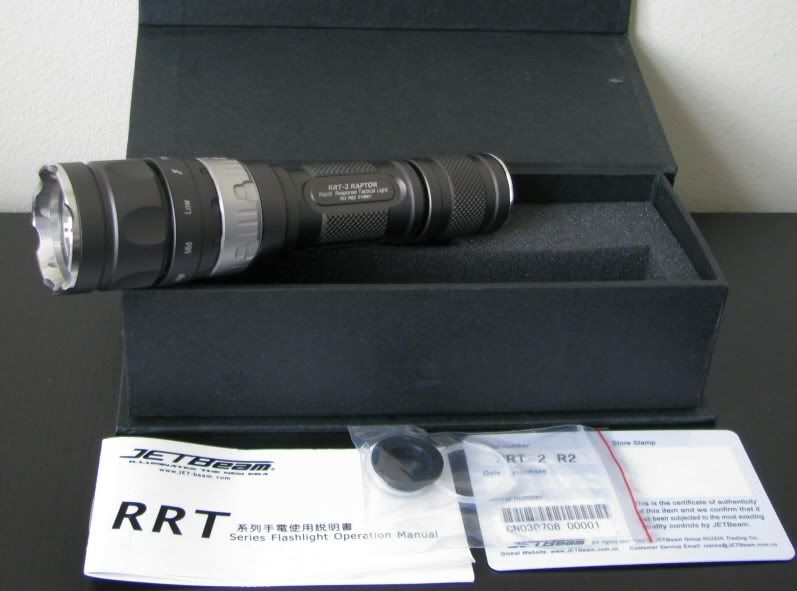
The RRT-2 comes in fairly standard JetBeam packaging for this size of light - a hard cardboard box with magnetic closing flap. The light comes with a manual, warranty card, spare o-rings, and spare tail-cap switch. Note there is no wrist strap or carrying pouch included on my sample.
One note to make up front – the user manual is rather inadequate for the light. Although it does cover the basics (i.e. how to turn on, insert a battery, and change light modes), it provides no detailed specs or background on the light. If you don't already know what batteries are supported, what components are built-in, etc., you are out of luck. :shrug: But it does emphasize the the fact that the "Standby" mode is not a true off, and should only be used as temporary off (see my UI discussion below).



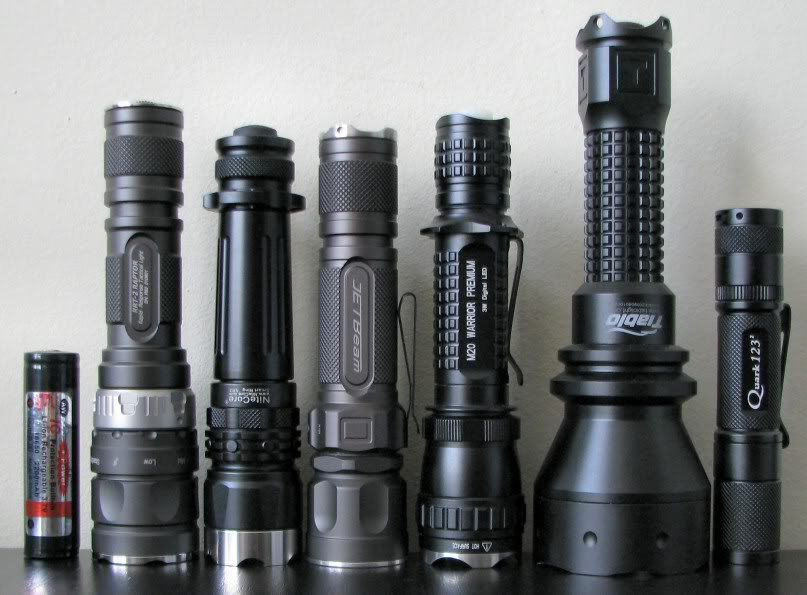
From left to right: 1xAW protected 18650, JetBeam RRT-2 Raptor, NiteCore SR3 + 18650 body tube, JetBeam Jet-III M, Olight M20, Tiablo A10-G, 4Sevens Quark 123.
Dimensions: Weight 172.4g, Length 150mm x Width 35mm (bezel)
The light is a bit larger than the typical 2xCR123A/18650 light, likely due to the control ring mechanism and deeper than typical reflector (for greater throw). I don't find it unreasonably longer.
Note the slightly scalloped bezel ring (stainless steel) and control switch ring (aluminium?) and the protruding forward clicky.
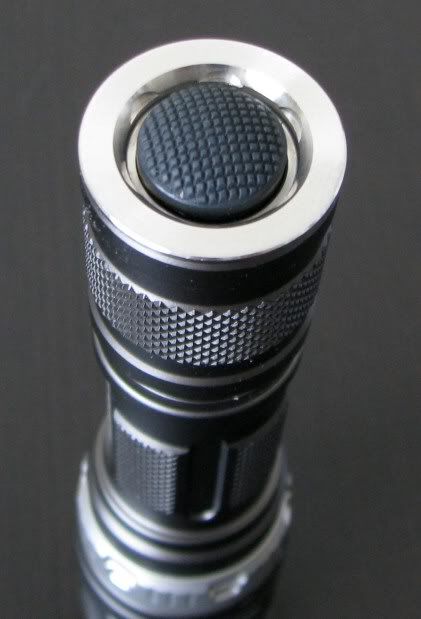
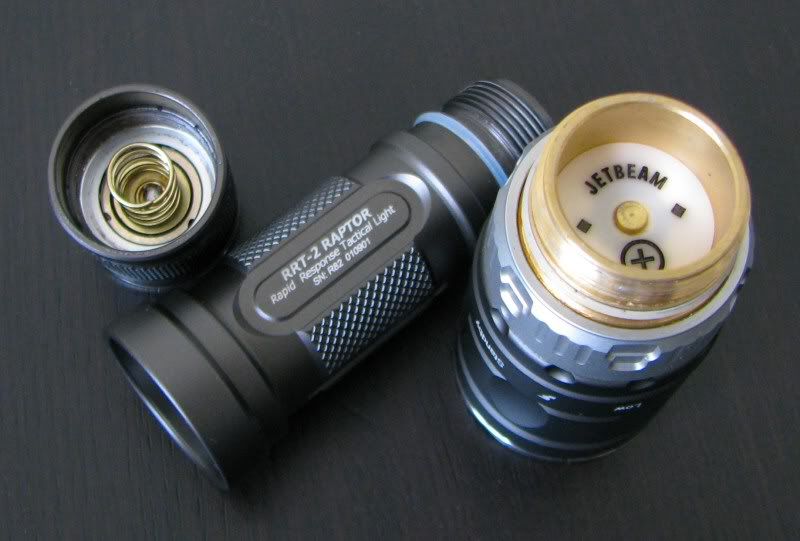
The clicky feel is very similar other modern JetBeam lights with a forward clicky. In fact, the entire tailcap assembly appears to be identical to my JetBeam M1X – they are interchangeable among the two lights.
Fit and finish are excellent on my sample, no flaws in the type-III hard anodizing (which is in JetBeam's typical dark-grey natural finish). There can often be significant mismatch in the color of natural anodizing between different components of a light, but my sample seems unusually consistent.
Identification labels are very sharp and clear, similar to the M1X (and an improvement over earlier JetBeam models). Labels are not as bright white as some other makers, but that actually helps to make them less obtrusive. Knurling is fairly standard for JetBeam (i.e. not very aggressive), but the presence of additional design elements with raised/flat portions helps with good hand grip.
Like other JetBeam models, screw threads are anodized for head or tailcap lock-out. :thumbsup: The light cannot tailstand, due to the forward clicky.
Note the significant brass heatsink in the head region of the light. oo:
oo:
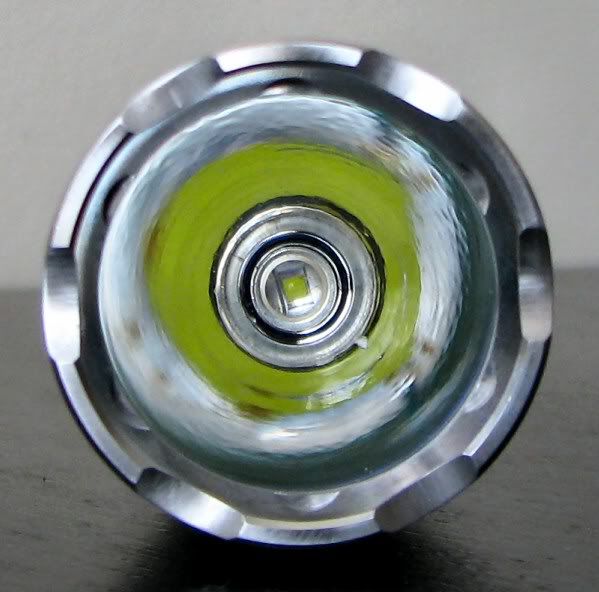
Despite how the photo above looks, the reflector is actually smooth. There appears to be an ever so-slight rippling pattern to it, which combined with the reflections of the scalloped bezel ring, give the misleading impression in the photo above.
The light uses the standard Cree XR-E emitter, with a R2 output bin in this case. As you will see in my beamshots below, my sample seems to be a premium white "cool tint" (I'd guestimate WC tint bin). Obviously, there will be some variability here – there is no guarantee as to what you could receive. Most R2s that I've seen have been on the warm green/yellow end of the "cool white" spectrum – likely WG/WH. For those of you not familiar with tint bins, please see my Colour tint comparison and the summary LED tint charts found here.
Observant viewers will note the apparent speck of debris or manufacturing defect on the smooth reflector (roughly 4 o'clock position). Please note that this is actually very misleading in the photo - it is a reflection of a much smaller defect, located closer to the emitter (i.e. it is being magnified by the angle, just as the yellow phosphor die of the emitter is being picked up and magnified by the reflector). :shrug:. Nothing you can do about it, and it doesn't seem to affect the beam.
UPDATE: I forgot to mention it originally, but the beam is somewhat focusable - you can twist the head region separately from the section with the output mode labels. In practice, all this does is let you defocus the beam slightly, as the range is limited. Helpful to allow you to achieve the best possible focus, but not much else. Mine came default at what I determined to be the best focus anyway.
Comparison Beamshots
Note that I inadvertently set the camera to an f-stop of 2.7 for the RRT-2 pics (instead of 3.2 for all my other reviews). So that will make everything seem a bit brighter on that RRT-2 row.
All lights are on 100% on an AW protected 18650, about 0.5 meters from a white wall.
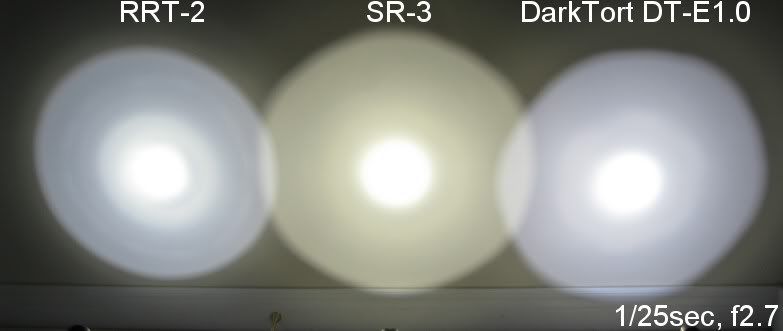
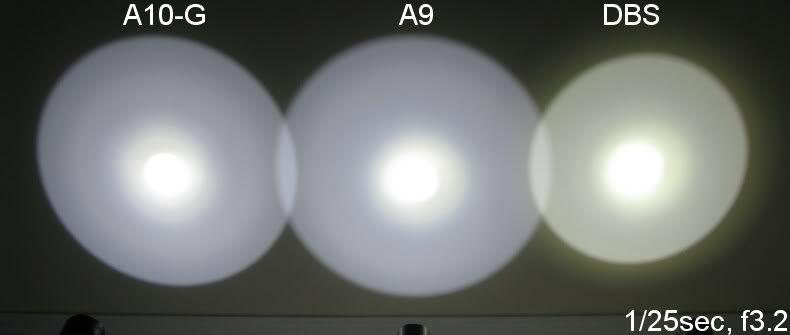
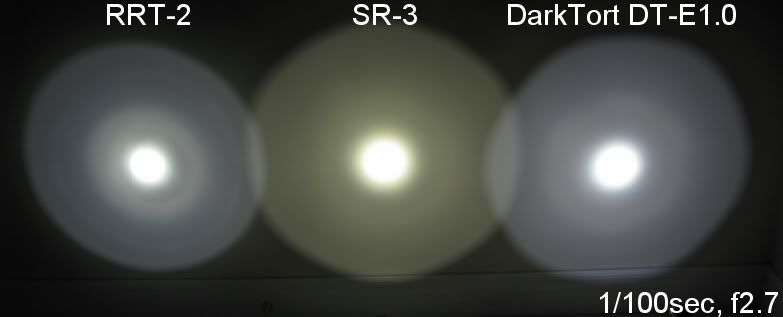
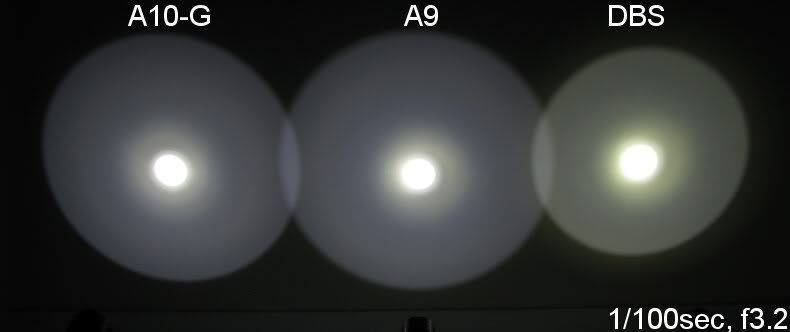
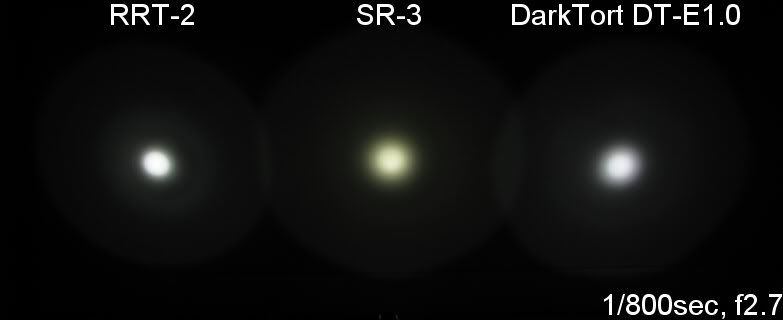
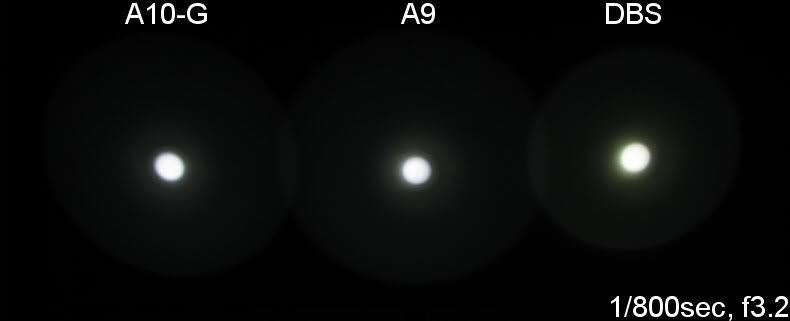
As you can see, the RRT-2 has a typical "thrower" appearance with a well-defined hotspot and some rings in the beam. On the whole, I don't find it too extreme in either aspect.
UPDATE: Some additional long-distance beamshots, to show you how the light compares to others in its class.
Please see my recent 100-yard Outdoor Beamshot review for more details (and additional lights).
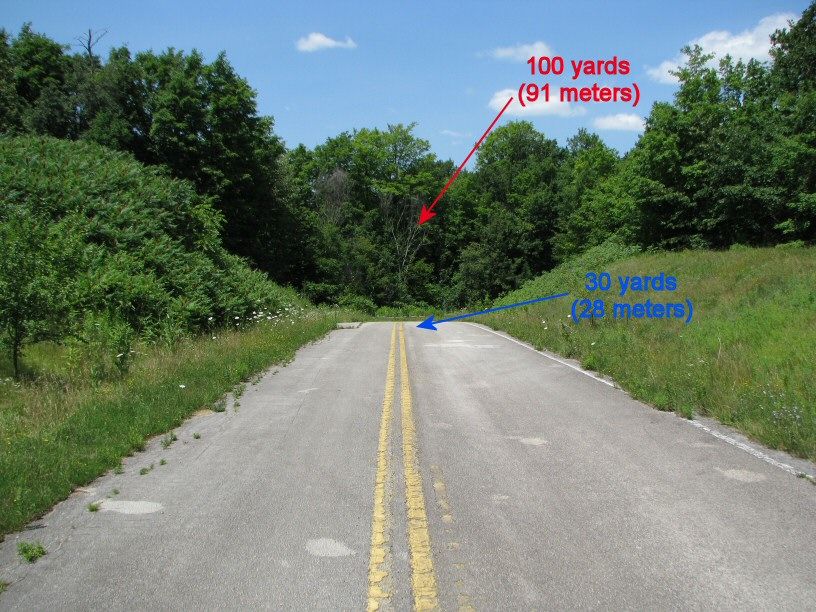
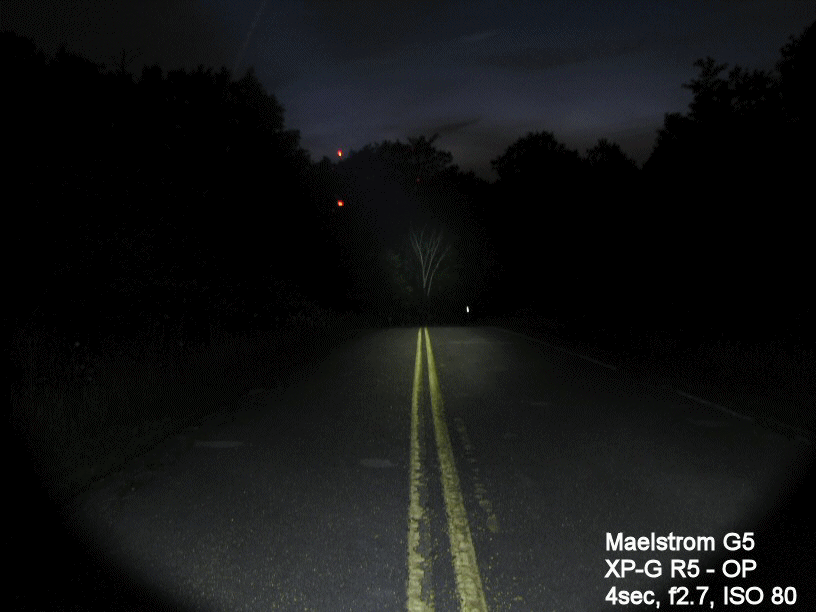
User Interface
The Raptor uses a new interface for JetBeam, previously well known for their continuously-variable IBS designs. This new interface is much simpler and very intuitive to use.
Light is turned on/off by the tailcap forward clicky (press for momentary, click to lock-on). Screw threads are anodized, so you could also use it like a twisty switch.
Output modes are controlled by a ring below the head. There are 3 constant output modes and an oscillating strobe mode, as well as a "standy mode" that is basically a temporary off. The closest comparables to this ring are the EagleTac M2-series lights and the new NiteCore SR3, although each model has its own particular aspects and features.
To access any of the 5 settings, simply turn the control ring. There is a dot indentation on the ring to tell you which mode you are currently in, by lining up with the marks on the head (something my EagleTac and NiteCore lights don't currently have, but may be in development). From left-to-right (i.e. clockwise if holding the light away from you in standard underhand carry), the dial turns from Hi – Mid – Lo – Strobe – Standby. There are pronounced detents at each level, so you feel the ring "click" into each output level as you reach it. The total traverse of the ring is less than half the total circumference of the light.
UPDATE: An unusual quirk - each mode has a brief low intensity flash and short delay before lighting up when you press the tailcap. CPFer HKJ reports the flash to be 20 micro-seconds long, followed by 120 milliseconds before full activation. On Standby mode, you will only see the 20 us flash.
"Standby"
The "standby" mode is like the "off" position of the ring on the EagleTac M2 lights – when in this position, no light is produced. However, on both lights, current is still being drawn to allow the circuit to respond to a change in the state of the ring. Unless the switch is clicked off or the current path is broken by locking out some part of the light, this "standby" mode will continue to draw power. As such, the name "standby" is more appropriate than off.
UPDATE: CPFer HKJ reports that the standby current is 2mA, which is fairly high for this sort of mode - it will completely drain your batteries within a month or two if left on like that (hence the warning in the manual).
What I don't quite get is why it is located after the strobe mode instead of after the lowest output mode. :sigh:
"Randomizing Strobe"
JetBeam describes the Strobe mode on the RRT-2 as a "randomizing strobe." That is not quite correct – it is in fact an oscillating strobe that switches between four distinct strobe frequencies very quickly. Each strobe frequency last ~0.5 secs, and they loop in continuous repeat, starting with the highest frequency. Here's what a 4 sec trace looks like:
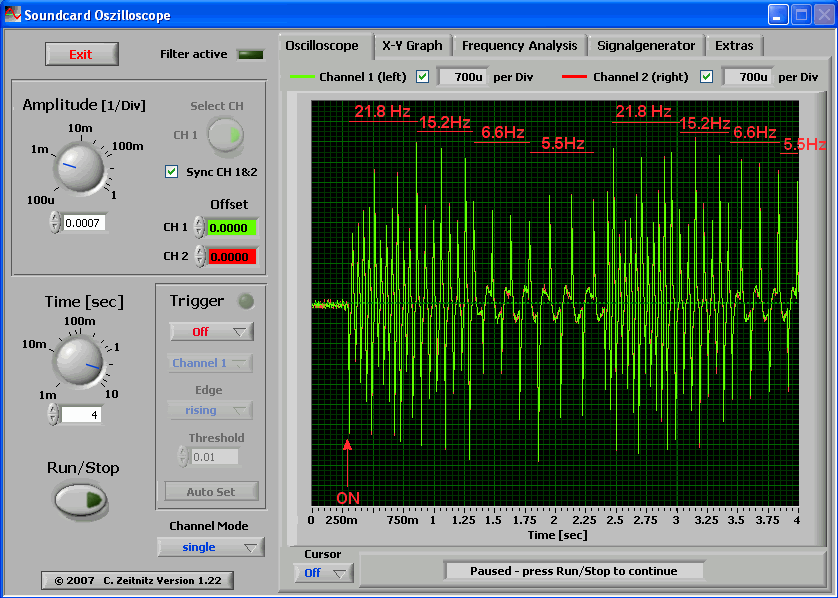
The light comes on in a very fast (and very annoying) 21.8 Hz strobe, followed by a just slightly less annoying 15.2 Hz, and then a 6.6 Hz and 5.5 Hz strobe. As I mentioned, each frequency lasts for about 0.5 secs, and then the whole thing repeats.
I am not really sure of the point of this. :thinking: Perhaps the reasoning is that by rapidly oscillating between four difference frequencies, the strobe is more disorienting? Personally, I doubt you could easily steel yourself against a constant strobe in the 15-20Hz range. I will leave it to your judgment as to how "tactical" this innovation is. :tinfoil: Is it "random"? No. Is it really, really annoying? You bet. :green:
No PWM (Pulse-Width-Modulation)
I was unable to detect any signs of PWM, and so must conclude that the RRT-2 doesn't use PWM to create its lower output modes. That would be consistent with the relatively bright Lo mode on the light (i.e. you typically need PWM to get down to really low outputs). I understand from Tohuwabohu's posts here CPF that the light is PFM (i.e. pulse-frequency-modulated) rather than classic current-controlled, but I don't have any other specifics.
Testing Method: All my output numbers are relative for my home-made light box setup, a la Quickbeam's flashlightreviews.com method. You can directly compare all my relative output values from different reviews - i.e. an output value of "10" in one graph is the same as "10" in another. All runtimes are done under a cooling fan, except for the extended run Lo/Min modes (i.e. >12 hours) which are done without cooling.
Throw values are the square-root of lux measurements taken at 1 meter from the lens, using a light meter.
Throw/Output Summary Chart:
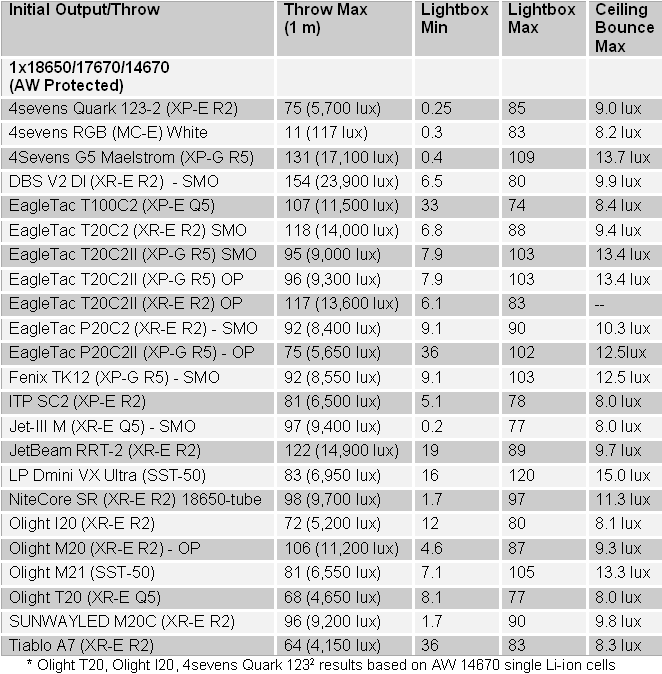

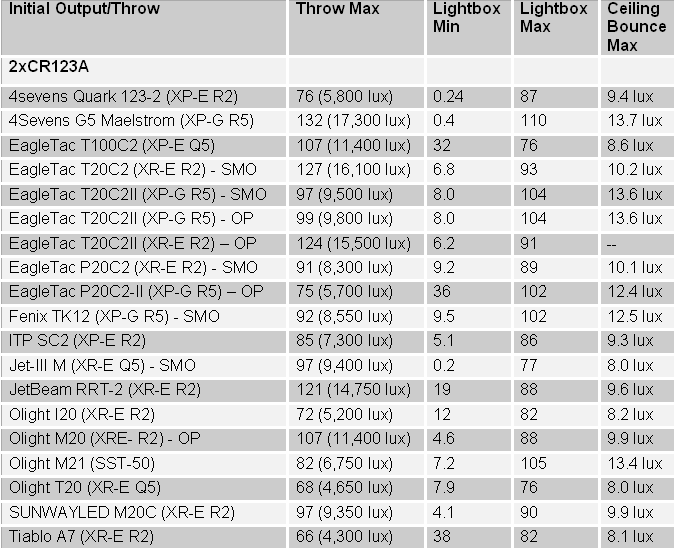
As you can see, the RRT-2 is more of a thrower than other multi-purpose lights in this size (e.g. JetBeam Jet-III M, Olight M20, NiteCore SR3 + 18650 tube) – but not hugely so. Obviously, throw can't compare to the dedicated modern throwers with bigger reflectors, like the Tiablo A10-G.
Overall max output on the RRT-2 is certainly very respectable for a multi-power R2-based light (i.e. about the same as the Quark 123-2 and Olight M20, on all batteries). But of course, the dedicated 1xLi-ion lights can potentially exceed it.
Min output is brighter than most of the other defined-output lights.
Output/Runtime Comparison:
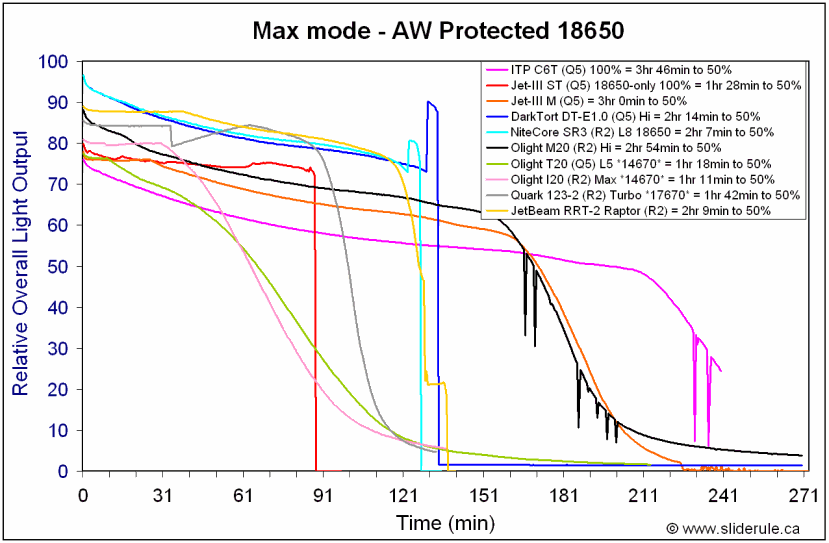
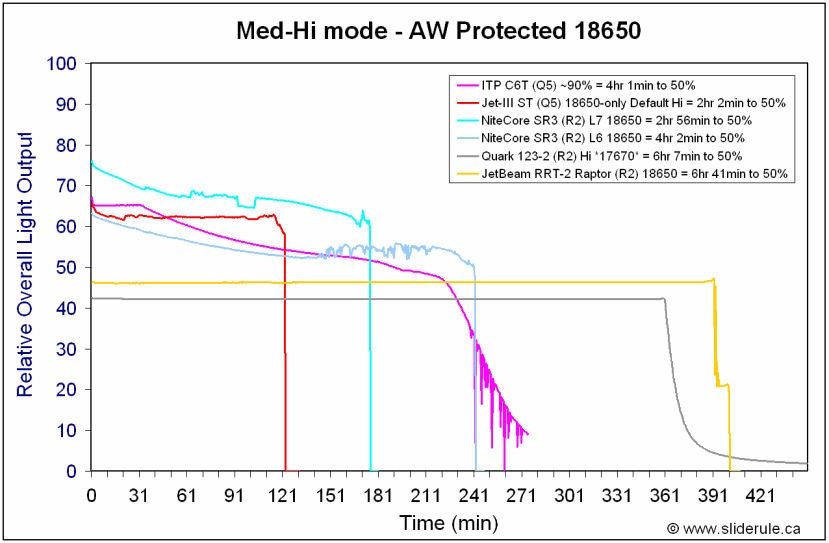
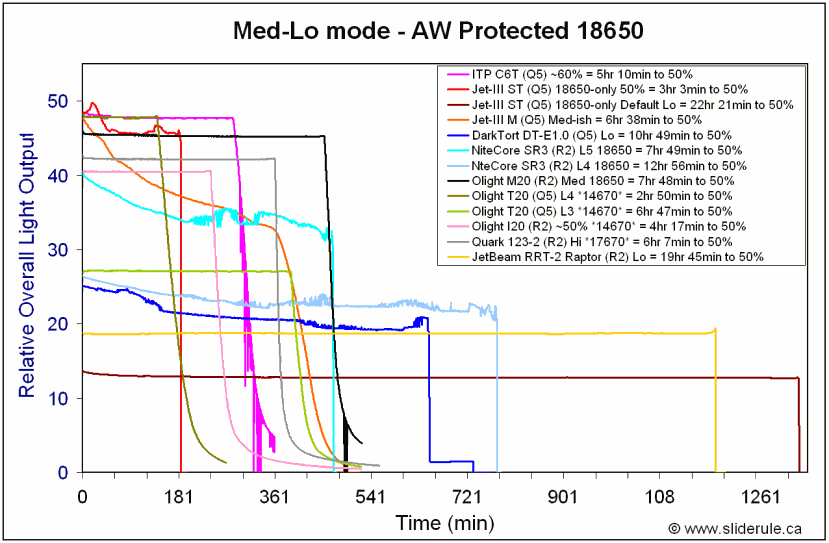
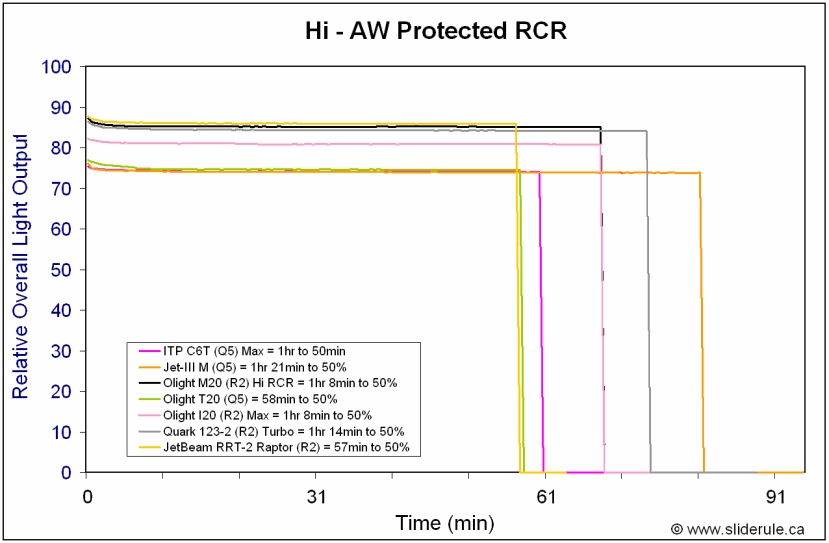
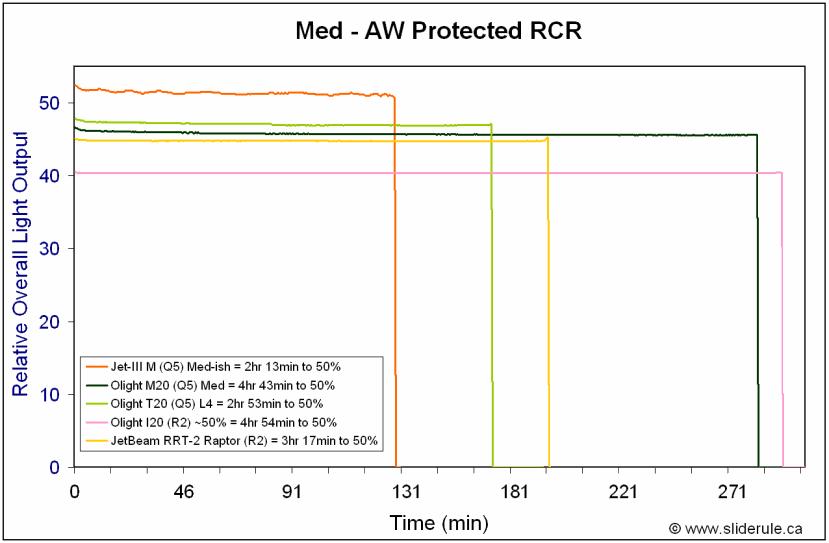
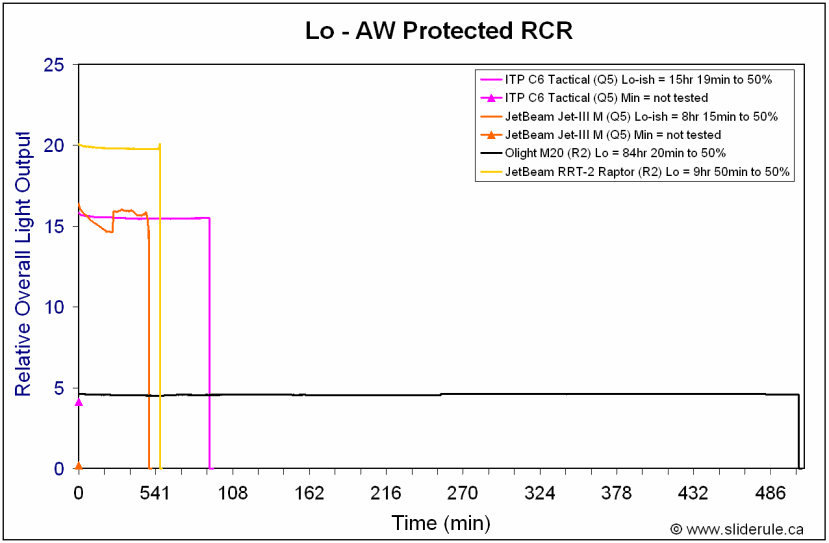

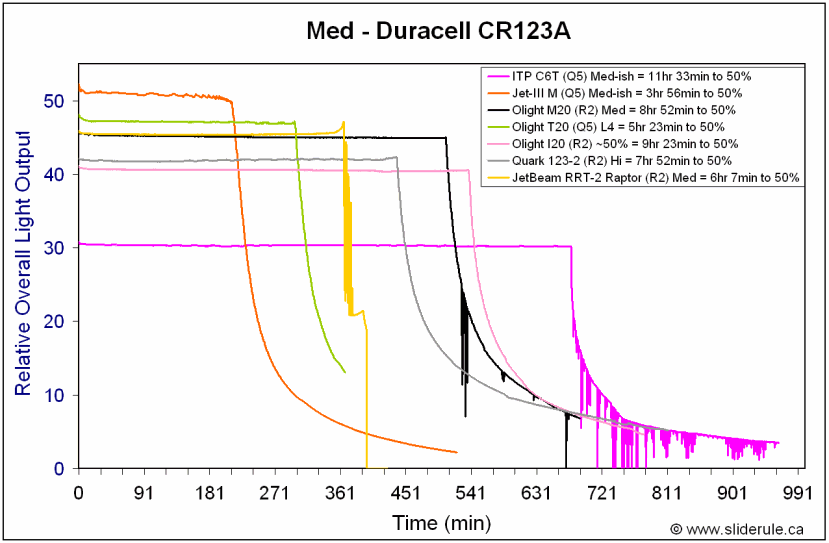
Runtime performance is generally quite good across the board. When matched for output, the RRT-2 can generally out-compete the continuously-variable competition (especially the older IBS-based lights). But relative to the defined-output group lights (many of which are current-controlled), it is really about an average performer.
Runtime pattern on 1x18650 and 2xCR123A is a little unusual once the light drops out of regulation. Normally on 18650, you get either an abrupt shut-down when the battery protection circuit is tripped, or a long decreasing output and "moon mode" phase. In the case of the RRT-2, the light appears to drop to a new regulated Med level for a short period of time before cutting out.
On 2xCR123A, the light appears to repeatedly attempt to return to a higher output, leading to rapidly switching output levels and quicker exhaustion of the batteries. :shrug: This is different from the low-voltage warning signal on the early ITP C6 and Olight M20 lights shown in the traces above (a feature I believe has since been removed from both lights).
Potential Issues
Being a new interface, the switching control ring may not suit all users. But I personally find it has the best feel among the three recent lights I've tested with a similar feature (i.e. compared to the EagleTac M2XC4 and NiteCore SR3).
Low mode is not as low as most other defined-output or continuously-variable lights.
Mode sequence is a bit odd, placing the strobe mode after the Lo mode (instead of after the Hi mode), and placing the standby mode after strobe (i.e. have to enter strobe before accessing standby?).
Runtime pattern is a little unusual on CR123A, once the light drops out of regulation.
No anti-roll features.
General Observations
The RRT-2 Raptor is JetBeam's offering in the new "one-ring-to-rule-them-all" world of flashlight design. I find it interesting to see how each maker has implemented the idea of a rotating control ring. JetBeam's ring design has the best "hand feel" to me (i.e. best combination of resistance and detents). It is also the easiest to figure out where you are (i.e. good surface markings). Like Goldilocks, I find the physical implementation of RRT-2 control ring to be just about right.
What I don't quite get is the sequence. :thinking: Why would you want to access strobe right after the lowest mode? And why would you put strobe between the standby mode and the constant output modes? A more sensible sequence in my mind would be Standby / Lo / Mid / Hi / Strobe (or the reverse order, if you prefer) - much like the EagleTac M2-series lights. UPDATE: thanks to a suggestion from CPFer gilly, I've discovered you can easily skip over the strobe mode by twisting the ring quickly. There is a ~120ms delay in the activation of each mode, so that seems to give you enough time to make it without seeing a strobe.
I am also not really clear on the advantage of this oscillating strobe sequence. I suspect constant strobe in the 10-20Hz range would be annoying enough for "tactical" use, but I'll leave that one to the experts to discuss. Given the trend toward ever-increasing :green: stobes, can I make a plea for someone to bring back the slow frequency blinking-style beacon strobe? I realize that this may not be the light for it, but I think "tactical" strobe is getting a bit over-done.
The lack of a true low mode may be disappointing to some, but I don't personally find it to be too big a drawback here. Although nice to have, I never really understood the exclusive bundling of really low modes on "thrower" lights (e.g. RaidFire Spear ). To me, it makes more sense to have a couple of battery-saving medium modes to extend runtime while keeping decent throw. But if a low mode is important to you on a light like this, you will need to look elsewhere.
). To me, it makes more sense to have a couple of battery-saving medium modes to extend runtime while keeping decent throw. But if a low mode is important to you on a light like this, you will need to look elsewhere.
I like the fact that the RRT-2 takes all possible battery configurations (i.e. 2xCR123A, 2xRCR, 1x18650). And with consistent output levels and regulated runtime patterns on each battery source. :thumbsup: Dedicated 18650-only lights may be capable of a bit more output, but you loose the flexibility to use primaries in a pinch.
Bottom line, the RRT-2 has a lot of nice touches. It also has excellent build quality - JetBeam has really managed to impress me with how solid their lights feel lately. But as always, what matters is whether or not it has the right combination of features and performance for you.
P.S.: I have justed tested them, and the Olight diffuser and filter kits for the Olight M20 are a perfect fit on the RRT-2. :twothumbs
P.P.S: Unlike many of the recent competition, the RRT-2 seems to be able to handle flat-top 18650 cells. :thumbsup: This is becoming an issue as more users begin to switch to the higher capacity protected 2600mAh cells (which lack the standard button top).
UPDATE SEPT 27, 2011: JetBeam has released a new series of RRT lights, with a continuously-variable interface. Please seen my recent RRT-21 and RRT-15 review for more info.
UPDATE SEPT 27, 2011: JetBeam has released a new series of RRT lights, with a continuously-variable interface. Please seen my recent RRT-21 and RRT-15 review for more info.
UPDATE SEPT 22, 2010: As this review is over a year old, it is not surprising that the RRT-2 has gone through a number of build modifications. Please see post #98 by Ecodelosandes for some detailed pics of the currently shipping XP-G R5 edition of the RRT-2.
Warning: Pic heavy!

Manufacturer's specifications, as taken from JetBeam's website:
- Rapid Response Activation Ring allows the user to select between the three various brightness levels and strobe function. Stainless steel ring, increased reliability and durability.
- Features new randomizing strobe
- Stainless steel bezels protect the head and tail cap from drops and impacts, crenulated bezel can be used as a glass breaker or defensive tool.
- CREE XR-E R2 LED
- Max output of 240 Lumen with an effective range of 300+ yards
- New hybrid reflector specially designed for CREE LED, which allows for better beam quality, efficiency and throw capability.
- Features a redesigned high efficiency broad voltage drive circuit.
- Compatible with both CR123 batteries and 18650 rechargeable Li-ions. (reviewer's note: RCR also appears to be supported)
- Floating positive end, designed for better battery contact.
- Built-in intelligent Li-ion rechargeable battery protection circuit.
- Impact-resistant meets US MIL-STD-810F accords.
- Meets IPX 8 waterproof standards
- Can utilize the "RM-01" tactical pressure switch and other available accessories
- Dimension: Head Diameter 35mm, Tube Diameter25.4mm, Total Length 145mm, Weight: 175g
The RRT-2 is the "second generation" of the JetBeam Raptor line. The original RRT-1 Raptor was designed to be a fairly strong "thrower" with a simple control-ring user interface. The revised version has a much smaller head, but still provides significant throw for its size, thanks to a deep reflector.

The RRT-2 comes in fairly standard JetBeam packaging for this size of light - a hard cardboard box with magnetic closing flap. The light comes with a manual, warranty card, spare o-rings, and spare tail-cap switch. Note there is no wrist strap or carrying pouch included on my sample.
One note to make up front – the user manual is rather inadequate for the light. Although it does cover the basics (i.e. how to turn on, insert a battery, and change light modes), it provides no detailed specs or background on the light. If you don't already know what batteries are supported, what components are built-in, etc., you are out of luck. :shrug: But it does emphasize the the fact that the "Standby" mode is not a true off, and should only be used as temporary off (see my UI discussion below).




From left to right: 1xAW protected 18650, JetBeam RRT-2 Raptor, NiteCore SR3 + 18650 body tube, JetBeam Jet-III M, Olight M20, Tiablo A10-G, 4Sevens Quark 123.
Dimensions: Weight 172.4g, Length 150mm x Width 35mm (bezel)
The light is a bit larger than the typical 2xCR123A/18650 light, likely due to the control ring mechanism and deeper than typical reflector (for greater throw). I don't find it unreasonably longer.
Note the slightly scalloped bezel ring (stainless steel) and control switch ring (aluminium?) and the protruding forward clicky.


The clicky feel is very similar other modern JetBeam lights with a forward clicky. In fact, the entire tailcap assembly appears to be identical to my JetBeam M1X – they are interchangeable among the two lights.
Fit and finish are excellent on my sample, no flaws in the type-III hard anodizing (which is in JetBeam's typical dark-grey natural finish). There can often be significant mismatch in the color of natural anodizing between different components of a light, but my sample seems unusually consistent.
Identification labels are very sharp and clear, similar to the M1X (and an improvement over earlier JetBeam models). Labels are not as bright white as some other makers, but that actually helps to make them less obtrusive. Knurling is fairly standard for JetBeam (i.e. not very aggressive), but the presence of additional design elements with raised/flat portions helps with good hand grip.
Like other JetBeam models, screw threads are anodized for head or tailcap lock-out. :thumbsup: The light cannot tailstand, due to the forward clicky.
Note the significant brass heatsink in the head region of the light.

Despite how the photo above looks, the reflector is actually smooth. There appears to be an ever so-slight rippling pattern to it, which combined with the reflections of the scalloped bezel ring, give the misleading impression in the photo above.
The light uses the standard Cree XR-E emitter, with a R2 output bin in this case. As you will see in my beamshots below, my sample seems to be a premium white "cool tint" (I'd guestimate WC tint bin). Obviously, there will be some variability here – there is no guarantee as to what you could receive. Most R2s that I've seen have been on the warm green/yellow end of the "cool white" spectrum – likely WG/WH. For those of you not familiar with tint bins, please see my Colour tint comparison and the summary LED tint charts found here.
Observant viewers will note the apparent speck of debris or manufacturing defect on the smooth reflector (roughly 4 o'clock position). Please note that this is actually very misleading in the photo - it is a reflection of a much smaller defect, located closer to the emitter (i.e. it is being magnified by the angle, just as the yellow phosphor die of the emitter is being picked up and magnified by the reflector). :shrug:. Nothing you can do about it, and it doesn't seem to affect the beam.
UPDATE: I forgot to mention it originally, but the beam is somewhat focusable - you can twist the head region separately from the section with the output mode labels. In practice, all this does is let you defocus the beam slightly, as the range is limited. Helpful to allow you to achieve the best possible focus, but not much else. Mine came default at what I determined to be the best focus anyway.
Comparison Beamshots
Note that I inadvertently set the camera to an f-stop of 2.7 for the RRT-2 pics (instead of 3.2 for all my other reviews). So that will make everything seem a bit brighter on that RRT-2 row.
All lights are on 100% on an AW protected 18650, about 0.5 meters from a white wall.






As you can see, the RRT-2 has a typical "thrower" appearance with a well-defined hotspot and some rings in the beam. On the whole, I don't find it too extreme in either aspect.
UPDATE: Some additional long-distance beamshots, to show you how the light compares to others in its class.
Please see my recent 100-yard Outdoor Beamshot review for more details (and additional lights).


User Interface
The Raptor uses a new interface for JetBeam, previously well known for their continuously-variable IBS designs. This new interface is much simpler and very intuitive to use.
Light is turned on/off by the tailcap forward clicky (press for momentary, click to lock-on). Screw threads are anodized, so you could also use it like a twisty switch.
Output modes are controlled by a ring below the head. There are 3 constant output modes and an oscillating strobe mode, as well as a "standy mode" that is basically a temporary off. The closest comparables to this ring are the EagleTac M2-series lights and the new NiteCore SR3, although each model has its own particular aspects and features.
To access any of the 5 settings, simply turn the control ring. There is a dot indentation on the ring to tell you which mode you are currently in, by lining up with the marks on the head (something my EagleTac and NiteCore lights don't currently have, but may be in development). From left-to-right (i.e. clockwise if holding the light away from you in standard underhand carry), the dial turns from Hi – Mid – Lo – Strobe – Standby. There are pronounced detents at each level, so you feel the ring "click" into each output level as you reach it. The total traverse of the ring is less than half the total circumference of the light.
UPDATE: An unusual quirk - each mode has a brief low intensity flash and short delay before lighting up when you press the tailcap. CPFer HKJ reports the flash to be 20 micro-seconds long, followed by 120 milliseconds before full activation. On Standby mode, you will only see the 20 us flash.
"Standby"
The "standby" mode is like the "off" position of the ring on the EagleTac M2 lights – when in this position, no light is produced. However, on both lights, current is still being drawn to allow the circuit to respond to a change in the state of the ring. Unless the switch is clicked off or the current path is broken by locking out some part of the light, this "standby" mode will continue to draw power. As such, the name "standby" is more appropriate than off.
UPDATE: CPFer HKJ reports that the standby current is 2mA, which is fairly high for this sort of mode - it will completely drain your batteries within a month or two if left on like that (hence the warning in the manual).
What I don't quite get is why it is located after the strobe mode instead of after the lowest output mode. :sigh:
"Randomizing Strobe"
JetBeam describes the Strobe mode on the RRT-2 as a "randomizing strobe." That is not quite correct – it is in fact an oscillating strobe that switches between four distinct strobe frequencies very quickly. Each strobe frequency last ~0.5 secs, and they loop in continuous repeat, starting with the highest frequency. Here's what a 4 sec trace looks like:

The light comes on in a very fast (and very annoying) 21.8 Hz strobe, followed by a just slightly less annoying 15.2 Hz, and then a 6.6 Hz and 5.5 Hz strobe. As I mentioned, each frequency lasts for about 0.5 secs, and then the whole thing repeats.
I am not really sure of the point of this. :thinking: Perhaps the reasoning is that by rapidly oscillating between four difference frequencies, the strobe is more disorienting? Personally, I doubt you could easily steel yourself against a constant strobe in the 15-20Hz range. I will leave it to your judgment as to how "tactical" this innovation is. :tinfoil: Is it "random"? No. Is it really, really annoying? You bet. :green:
No PWM (Pulse-Width-Modulation)
I was unable to detect any signs of PWM, and so must conclude that the RRT-2 doesn't use PWM to create its lower output modes. That would be consistent with the relatively bright Lo mode on the light (i.e. you typically need PWM to get down to really low outputs). I understand from Tohuwabohu's posts here CPF that the light is PFM (i.e. pulse-frequency-modulated) rather than classic current-controlled, but I don't have any other specifics.
Testing Method: All my output numbers are relative for my home-made light box setup, a la Quickbeam's flashlightreviews.com method. You can directly compare all my relative output values from different reviews - i.e. an output value of "10" in one graph is the same as "10" in another. All runtimes are done under a cooling fan, except for the extended run Lo/Min modes (i.e. >12 hours) which are done without cooling.
Throw values are the square-root of lux measurements taken at 1 meter from the lens, using a light meter.
Throw/Output Summary Chart:



As you can see, the RRT-2 is more of a thrower than other multi-purpose lights in this size (e.g. JetBeam Jet-III M, Olight M20, NiteCore SR3 + 18650 tube) – but not hugely so. Obviously, throw can't compare to the dedicated modern throwers with bigger reflectors, like the Tiablo A10-G.
Overall max output on the RRT-2 is certainly very respectable for a multi-power R2-based light (i.e. about the same as the Quark 123-2 and Olight M20, on all batteries). But of course, the dedicated 1xLi-ion lights can potentially exceed it.
Min output is brighter than most of the other defined-output lights.
Output/Runtime Comparison:








Runtime performance is generally quite good across the board. When matched for output, the RRT-2 can generally out-compete the continuously-variable competition (especially the older IBS-based lights). But relative to the defined-output group lights (many of which are current-controlled), it is really about an average performer.
Runtime pattern on 1x18650 and 2xCR123A is a little unusual once the light drops out of regulation. Normally on 18650, you get either an abrupt shut-down when the battery protection circuit is tripped, or a long decreasing output and "moon mode" phase. In the case of the RRT-2, the light appears to drop to a new regulated Med level for a short period of time before cutting out.
On 2xCR123A, the light appears to repeatedly attempt to return to a higher output, leading to rapidly switching output levels and quicker exhaustion of the batteries. :shrug: This is different from the low-voltage warning signal on the early ITP C6 and Olight M20 lights shown in the traces above (a feature I believe has since been removed from both lights).
Potential Issues
Being a new interface, the switching control ring may not suit all users. But I personally find it has the best feel among the three recent lights I've tested with a similar feature (i.e. compared to the EagleTac M2XC4 and NiteCore SR3).
Low mode is not as low as most other defined-output or continuously-variable lights.
Mode sequence is a bit odd, placing the strobe mode after the Lo mode (instead of after the Hi mode), and placing the standby mode after strobe (i.e. have to enter strobe before accessing standby?).
Runtime pattern is a little unusual on CR123A, once the light drops out of regulation.
No anti-roll features.
General Observations
The RRT-2 Raptor is JetBeam's offering in the new "one-ring-to-rule-them-all" world of flashlight design. I find it interesting to see how each maker has implemented the idea of a rotating control ring. JetBeam's ring design has the best "hand feel" to me (i.e. best combination of resistance and detents). It is also the easiest to figure out where you are (i.e. good surface markings). Like Goldilocks, I find the physical implementation of RRT-2 control ring to be just about right.
What I don't quite get is the sequence. :thinking: Why would you want to access strobe right after the lowest mode? And why would you put strobe between the standby mode and the constant output modes? A more sensible sequence in my mind would be Standby / Lo / Mid / Hi / Strobe (or the reverse order, if you prefer) - much like the EagleTac M2-series lights. UPDATE: thanks to a suggestion from CPFer gilly, I've discovered you can easily skip over the strobe mode by twisting the ring quickly. There is a ~120ms delay in the activation of each mode, so that seems to give you enough time to make it without seeing a strobe.
I am also not really clear on the advantage of this oscillating strobe sequence. I suspect constant strobe in the 10-20Hz range would be annoying enough for "tactical" use, but I'll leave that one to the experts to discuss. Given the trend toward ever-increasing :green: stobes, can I make a plea for someone to bring back the slow frequency blinking-style beacon strobe? I realize that this may not be the light for it, but I think "tactical" strobe is getting a bit over-done.
The lack of a true low mode may be disappointing to some, but I don't personally find it to be too big a drawback here. Although nice to have, I never really understood the exclusive bundling of really low modes on "thrower" lights (e.g. RaidFire Spear
 ). To me, it makes more sense to have a couple of battery-saving medium modes to extend runtime while keeping decent throw. But if a low mode is important to you on a light like this, you will need to look elsewhere.
). To me, it makes more sense to have a couple of battery-saving medium modes to extend runtime while keeping decent throw. But if a low mode is important to you on a light like this, you will need to look elsewhere.I like the fact that the RRT-2 takes all possible battery configurations (i.e. 2xCR123A, 2xRCR, 1x18650). And with consistent output levels and regulated runtime patterns on each battery source. :thumbsup: Dedicated 18650-only lights may be capable of a bit more output, but you loose the flexibility to use primaries in a pinch.
Bottom line, the RRT-2 has a lot of nice touches. It also has excellent build quality - JetBeam has really managed to impress me with how solid their lights feel lately. But as always, what matters is whether or not it has the right combination of features and performance for you.
P.S.: I have justed tested them, and the Olight diffuser and filter kits for the Olight M20 are a perfect fit on the RRT-2. :twothumbs
P.P.S: Unlike many of the recent competition, the RRT-2 seems to be able to handle flat-top 18650 cells. :thumbsup: This is becoming an issue as more users begin to switch to the higher capacity protected 2600mAh cells (which lack the standard button top).
UPDATE SEPT 27, 2011: JetBeam has released a new series of RRT lights, with a continuously-variable interface. Please seen my recent RRT-21 and RRT-15 review for more info.
Last edited:


